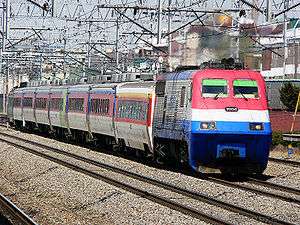EMD FT36HCW-2
The EMD FT36CW-2, classified as the Class 7000 locomotive under Korail, was a Korean semi-high-speed diesel locomotive. It was built to make the Saemaul Class trains more streamlined before the 1988 Olympics. The locomotives were built between 1986 and 1987 and were all retired between 2011 and 2012 when they reached the end of their 25-year lifespans.
| EMD FT36HCW-2 | |||||||||||||||||||||
|---|---|---|---|---|---|---|---|---|---|---|---|---|---|---|---|---|---|---|---|---|---|
 FT36HCW-2 7006 running as a Mugunghwa train. | |||||||||||||||||||||
| |||||||||||||||||||||
| |||||||||||||||||||||
| |||||||||||||||||||||
| |||||||||||||||||||||
Specifications
The FT36HCW-2 is only capable of hauling passenger cars.
The braking system is of an electric type, unlike the air brakes used on the larger GT26CW and GT26CW2 diesel-electric locomotives. However, dynamic braking was prohibited from use due to the aging of the traction motors.
The cab only had windows on one side of the train, so it was hard to see in the other side of the train. Therefore, the top speed when driving in slower speeds was limited to 25 km/h.
History
- June 1986: Units 7001-7009 are introduced into service.
- July 1987: Units 7010-7015 are introduced into service. These units had several slight changes.
- 2011: Units 7001-7009 are retired. Unit 7001 is slated for preservation.
- November 28, 2012: Units 7010-7015 are retired.
Modifications
The FT36HCW-2s were equipped with head-end power (HEP). However, the power supply caused many problems, and excessive noise and frequent maintenance led to the decision by Korail to remove HEP from the cars and instead use dynamo cars to provide the head-end power.
The locomotives also were originally powered by EMD 16-645F3B 3500-horsepower engines, but were eventually repowered with more efficient 3000-horsepower EMD 16-645E3 to satisfy passengers and customers.
The front coupler was initially housed, but was converted to an external convex to resolve efficiency problems.
Trains and statuses
There were fifteen FT36HCW-2 locomotives, all of which were classified as Class 7000 locomotives. A detailed list of the fifteen units is below.
| Car Number | Retirement Year | Notes |
|---|---|---|
| 7001 | 2011 | Preserved by the Korea Railroad Cultural Heritage Committee. |
| 7002 | Sold & scrapped in 2015[1] | |
| 7003 | Damaged in an accident at Jeonui Station on June 21, 1990 as a Saemaeul train, but was repaired. Sold & scrapped in 2018 | |
| 7004 | Sold & scrapped in 2015[1] | |
| 7005 | Sold & scrapped in 2016[2] | |
| 7006 | ||
| 7007 | ||
| 7008 | ||
| 7009 | Sold & scrapped in 2018 | |
| 7010 | 2012 | Sold & scrapped in 2015[1] |
| 7011 | Last unit in service on, November 28, 2012. Sold & scrapped in 2015[1] | |
| 7012 | Sold & scrapped in 2018 | |
| 7013 | Involved in an accident on the Daegu line on June 14, 2008 as a Mugunghwa train, but was repaired.[3] Sold & scrapped in 2018 | |
| 7014 | Sold & scrapped in 2015[1] | |
| 7015 | Sold & scrapped in 2015[2] |